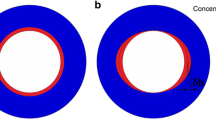Abstract
Recent seismological studies1,2 have suggested that the inner core is rotating relative to the bulk of the Earth, a situation which (according to numerical simulations3) may be sustained by convective flow in the liquid outer core. On the other hand, large gravitational forces due to the heterogeneous distribution of mass in the Earth's mantle should be sufficient to keep the inner core aligned with the mantle4. Here I show that the differential rotation of the inner core can be reconciled with these strong gravitational forces by allowing the shape of the inner core to adjust as it rotates, so permitting an estimate of the effective viscosity of this innermost region of the Earth. The inferred rotation rate constrains the viscosity of the inner core to be less than 1016 Pa s or greater than 1020 Pa s, as two different dynamical regimes are possible. The viscosity estimates for these two regimes have very different implications for the origin of seismic anisotropy in the inner core.


Similar content being viewed by others
References
Song, X. & Richards, P. Seismological evidence for the rotation of the Earth's inner core. Nature 382, 221–224 (1996).
Su, W.-J., Dziewonski, A. M. & Jeanloz, R. Planet within a planet: rotation of the inner core of the Earth. Science 274, 1883–1887 (1996).
Glatzmaier, G. & Roberts, P. H. Rotation and magnetism of Earth's inner core. Science 274, 1887–1891 (1996).
Buffett, B. A. Amechanism for decade fluctuations in the length of day. Geophys. Res. Lett. 23, 3803–3806 (1996).
Creager, K. C. Anisotropy of the inner core from differential travel times of phases PKP and PKIKP. Nature 356, 309–314 (1992).
Song, X. & Helmberger, D. V. Depth dependence of anisotropy of Earth's inner core. J. Geophys. Res. 100, 9805–9816 (1995).
Su, W.-J. & Dziewonski, A. M. Inner core anisotropy in three dimensions. J. Geophys. Res. 100, 9831–9852 (1995).
Glatzmaier, G. & Roberts, P. H. An anelastic evolutionary geodynamo simulation driven by compositional and thermal convection. Physica D 97, 81–94 (1996).
Aurnou, J. M., Brito, M. & Olson, P. L. Mechanics of inner core super-rotation. Geophys. Res. Lett. 23, 3401–3404 (1996).
Forte, A. & Peltier, W. R. Viscous flow models of global geophysical observables, 1 Forward problems. J. Geophys. Res. 99, 21857–21877 (1991).
Edmonds, A. R. Angular Momentum in Quantum Mechanics(Princeton Univ. Press, (1960)
Hager, B. H. & Clayton, R. W. in Mantle Conveciton(Gordon & Breach, New York, (1989)).
Loper, D. E. & Roberts, P. H. Astudy of conditions at the inner core boundary of the Earth. Phys. Earth Planet. Inter. 24, 302–307 (1981).
Yoshida, S., Sumita, I. & Kumazawa, M. Growth model of the inner core coupled with outer core dynamics and the resulting elastic anisotropy. J. Geophys. Res. 101, 2805–28103 (1996).
Poirier, J.-P. Creep of Crystals: High-temperature Deformation Processes in Metals, Ceramics, and Minerals(Cambridge Univ. Press, (1985)).
Frost, H. J. & Ashby, M. F. Deformation Mechanism MapsCh. 4 (Pergamon, Oxford, (1983)).
Stixrude, L. & Cohen, R. E. High-pressure elasticity of iron and anisotropy of Earth's inner core. Science 267, 1972–1975 (1995).
Anderson, D. L. Earth's viscosity. Science 151, 321–322 (1966).
Widmer, R., Masters, G. & Gilbert, F. Spherically symmetric attenuation within the Earth from normal mode data. Geophys. J. Int. 104, 541–553 (1991).
Jeanloz, R. & Wenk, H.-R. Convection and anisotropy of the inner core. Geophys. Res. Lett. 15, 72–75 (1988).
Sumita, I., Yoshida, S., Kumazawa, M. & Hamano, Y. Amodel for sedimentary compaction of a viscous medium and its application to inner-core growth. Geophys. J. Int. 124, 502–524 (1996).
Acknowledgements
I thank J. Bloxham, B. Hager, P. Richards and D. Stevenson for comments and suggestions. J. Bloxham and D. Stevenson independently suggested the possibility of the high-viscosity solution. This work was supported by NSERC.
Author information
Authors and Affiliations
Corresponding author
Rights and permissions
About this article
Cite this article
Buffett, B. Geodynamic estimates of the viscosity of the Earth's inner core. Nature 388, 571–573 (1997). https://doi.org/10.1038/41534
Received:
Accepted:
Issue Date:
DOI: https://doi.org/10.1038/41534
- Springer Nature Limited
This article is cited by
-
Ab initio determination on diffusion coefficient and viscosity of FeNi fluid under Earth’s core condition
Scientific Reports (2022)
-
Gravity Variations and Ground Deformations Resulting from Core Dynamics
Surveys in Geophysics (2022)
-
Viscosity of hcp iron at Earth’s inner core conditions from density functional theory
Scientific Reports (2020)
-
Weak magnetic field changes over the Pacific due to high conductance in lowermost mantle
Nature Geoscience (2020)
-
Low viscosity of the Earth’s inner core
Nature Communications (2019)





